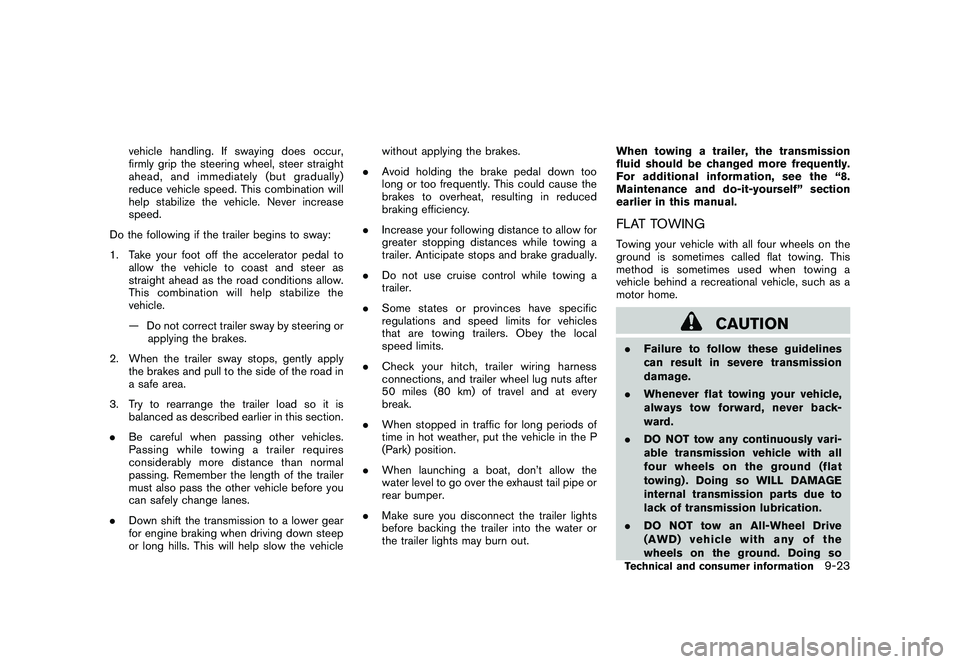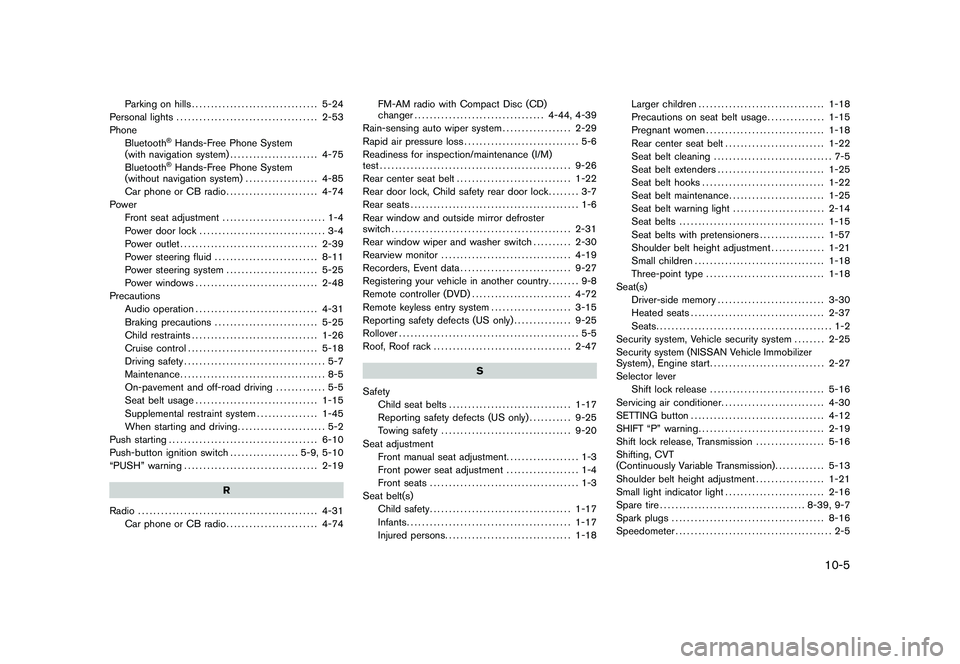2010 NISSAN MURANO manual transmission
[x] Cancel search: manual transmissionPage 411 of 425

Black plate (411,1)
Model "Z51-D" EDITED: 2009/ 8/ 3
vehicle handling. If swaying does occur,
firmly grip the steering wheel, steer straight
ahead, and immediately (but gradually)
reduce vehicle speed. This combination will
help stabilize the vehicle. Never increase
speed.
Do the following if the trailer begins to sway:
1. Take your foot off the accelerator pedal to allow the vehicle to coast and steer as
straight ahead as the road conditions allow.
This combination will help stabilize the
vehicle.
— Do not correct trailer sway by steering orapplying the brakes.
2. When the trailer sway stops, gently apply the brakes and pull to the side of the road in
a safe area.
3. Try to rearrange the trailer load so it is balanced as described earlier in this section.
. Be careful when passing other vehicles.
Passing while towing a trailer requires
considerably more distance than normal
passing. Remember the length of the trailer
must also pass the other vehicle before you
can safely change lanes.
. Down shift the transmission to a lower gear
for engine braking when driving down steep
or long hills. This will help slow the vehicle without applying the brakes.
. Avoid holding the brake pedal down too
long or too frequently. This could cause the
brakes to overheat, resulting in reduced
braking efficiency.
. Increase your following distance to allow for
greater stopping distances while towing a
trailer. Anticipate stops and brake gradually.
. Do not use cruise control while towing a
trailer.
. Some states or provinces have specific
regulations and speed limits for vehicles
that are towing trailers. Obey the local
speed limits.
. Check your hitch, trailer wiring harness
connections, and trailer wheel lug nuts after
50 miles (80 km) of travel and at every
break.
. When stopped in traffic for long periods of
time in hot weather, put the vehicle in the P
(Park) position.
. When launching a boat, don’t allow the
water level to go over the exhaust tail pipe or
rear bumper.
. Make sure you disconnect the trailer lights
before backing the trailer into the water or
the trailer lights may burn out. When towing a trailer, the transmission
fluid should be changed more frequently.
For additional information, see the “8.
Maintenance and do-it-yourself” section
earlier in this manual.
FLAT TOWINGTowing your vehicle with all four wheels on the
ground is sometimes called flat towing. This
method is sometimes used when towing a
vehicle behind a recreational vehicle, such as a
motor home.
CAUTION
.
Failure to follow these guidelines
can result in severe transmission
damage.
. Whenever flat towing your vehicle,
always tow forward, never back-
ward.
. DO NOT tow any continuously vari-
able transmission vehicle with all
four wheels on the ground (flat
towing) . Doing so WILL DAMAGE
internal transmission parts due to
lack of transmission lubrication.
. DO NOT tow an All-Wheel Drive
(AWD) vehicle with any of the
wheels on the ground. Doing soTechnical and consumer information
9-23
Page 412 of 425

Black plate (412,1)
Model "Z51-D" EDITED: 2009/ 8/ 3
may cause serious and expensive
damage to the powertrain.
. For emergency towing procedures
refer to “TOWING RECOMMENDED
BY NISSAN” in the “6. In case of
emergency” section of this manual.
Continuously Variable Transmission
(CVT)All-Wheel Drive (AWD) models:
Do not tow an AWD vehicle with any of the
wheels on the ground.
Two-Wheel Drive (2WD) models:
To tow a vehicle equipped with a Continuously
Variable Transmission (CVT) , an appropriate
vehicle dolly MUSTbe placed under the towed
vehicle’s driving wheels. Alwaysfollow the dolly
manufacturer’s recommendations when using
their product. DOT (Department Of Transportation) Quality
Grades: All passenger car tires must conform to
federal safety requirements in addition to these
grades.
Quality grades can be found where applicable
on the tire sidewall between tread shoulder and
maximum section width. For example:
Treadwear 200 Traction AA Temperature A
TREADWEARThe treadwear grade is a comparative rating
based on the wear rate of the tire when tested
under controlled conditions on a specified
government test course. For example, a tire
graded 150 would wear one and one-half
(1 1/2) times as well on the government course
as a tire graded 100. The relative performance
of tires depends upon actual conditions of their
use, however, and may depart significantly from
the norm due to variations in driving habits,
service practices and differences in road char-
acteristics and climate.TRACTION AA, A, B AND CThe traction grades, from highest to lowest, are
AA, A, B and C. Those grades represent the
tire’s ability to stop on wet pavement as
measured under controlled conditions on spe-
cified government test surfaces of asphalt and
concrete. A tire marked C may have poor
traction performance.
WARNING
The traction grade assigned to this tire
is based on straight-ahead braking
traction tests, and does not include
acceleration, cornering, hydroplaning,
or peak traction characteristics.TEMPERATURE A, B AND CThe temperature grades A (the highest) , B, and
C, representing the tire’s resistance to the
generation of heat and its ability to dissipate
heat when tested under controlled conditions on
a specified indoor laboratory test wheel. Sus-
tained high temperature can cause the material
of the tire to degenerate and reduce tire life, and
excessive temperature can lead to sudden tire
failure. The grade C corresponds to a level of
performance which all passenger car tires must
meet under the Federal Motor Vehicle Safety
Standard No. 109. Grades B and A represent
higher levels of performance on the laboratory
test wheel than the minimum required by law.
WARNING
The temperature grade for this tire is
established for a tire that is properly
inflated and not overloaded. Excessive
speed, under-inflation, or excessive
UNIFORM TIRE QUALITY GRADING
9-24
Technical and consumer information
Page 421 of 425

Black plate (5,1)
Parking on hills................................. 5-24
Personal lights ..................................... 2-53
Phone Bluetooth
®Hands-Free Phone System
(with navigation system) ....................... 4-75
Bluetooth®Hands-Free Phone System
(without navigation system) ................... 4-85
Car phone or CB radio ........................ 4-74
Power Front seat adjustment ........................... 1-4
Power door lock ................................. 3-4
Power outlet .................................... 2-39
Power steering fluid ........................... 8-11
Power steering system ........................ 5-25
Power windows ................................ 2-48
Precautions
Audio operation ................................ 4-31
Braking precautions ........................... 5-25
Child restraints ................................. 1-26
Cruise control .................................. 5-18
Driving safety ..................................... 5-7
Maintenance ...................................... 8-5
On-pavement and off-road driving ............. 5-5
Seat belt usage ................................ 1-15
Supplemental restraint system ................ 1-45
When starting and driving ....................... 5-2
Push starting ....................................... 6-10
Push-button ignition switch .................. 5-9, 5-10
“PUSH” warning ................................... 2-19
R
Radio ............................................... 4-31
Car phone or CB radio ........................ 4-74 FM-AM radio with Compact Disc (CD)
changer
.................................. 4-44, 4-39
Rain-sensing auto wiper system .................. 2-29
Rapid air pressure loss .............................. 5-6
Readiness for inspection/maintenance (I/M)
test .................................................. 9-26
Rear center seat belt .............................. 1-22
Rear door lock, Child safety rear door lock ........ 3-7
Rear seats ............................................ 1-6
Rear window and outside mirror defroster
switch ............................................... 2-31
Rear window wiper and washer switch .......... 2-30
Rearview monitor .................................. 4-19
Recorders, Event data ............................. 9-27
Registering your vehicle in another country ........ 9-8
Remote controller (DVD) .......................... 4-72
Remote keyless entry system ..................... 3-15
Reporting safety defects (US only) ............... 9-25
Rollover ............................................... 5-5
Roof, Roof rack .................................... 2-47
S
Safety Child seat belts ................................ 1-17
Reporting safety defects (US only) ........... 9-25
Towing safety .................................. 9-20
Seat adjustment Front manual seat adjustment. .................. 1-3
Front power seat adjustment ................... 1-4
Front seats ....................................... 1-3
Seat belt(s) Child safety ..................................... 1-17
Infants ........................................... 1-17
Injured persons ................................. 1-18 Larger children
................................. 1-18
Precautions on seat belt usage ............... 1-15
Pregnant women ............................... 1-18
Rear center seat belt .......................... 1-22
Seat belt cleaning ............................... 7-5
Seat belt extenders ............................ 1-25
Seat belt hooks ................................ 1-22
Seat belt maintenance ......................... 1-25
Seat belt warning light ........................ 2-14
Seat belts ...................................... 1-15
Seat belts with pretensioners ................. 1-57
Shoulder belt height adjustment .............. 1-21
Small children .................................. 1-18
Three-point type ............................... 1-18
Seat(s) Driver-side memory ............................ 3-30
Heated seats ................................... 2-37
Seats .............................................. 1-2
Security system, Vehicle security system ........ 2-25
Security system (NISSAN Vehicle Immobilizer
System) , Engine start .............................. 2-27
Selector lever Shift lock release .............................. 5-16
Servicing air conditioner ........................... 4-30
SETTING button ................................... 4-12
SHIFT “P” warning ................................. 2-19
Shift lock release, Transmission .................. 5-16
Shifting, CVT
(Continuously Variable Transmission) ............. 5-13
Shoulder belt height adjustment .................. 1-21
Small light indicator light .......................... 2-16
Spare tire ...................................... 8-39, 9-7
Spark plugs ........................................ 8-16
Speedometer ......................................... 2-5
10-5
Model "Z51-D" EDITED: 2009/ 8/ 3